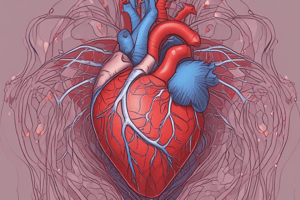Podcast
Questions and Answers
What is the primary characteristic of tachycardia?
What is the primary characteristic of tachycardia?
- It indicates a feeling of constriction around the heart.
- It involves irregular heart rhythms.
- It refers to slow heartbeats.
- It is characterized by rapidly beating heart. (correct)
Which instrument is used to measure blood pressure?
Which instrument is used to measure blood pressure?
- Sphygmomanometer (correct)
- Stethoscope
- Cardiac resuscitation device
- Electrocardiograph
Which term describes a feeling of constriction around the heart usually caused by insufficient blood supply?
Which term describes a feeling of constriction around the heart usually caused by insufficient blood supply?
- Angina pectoris (correct)
- Bradycardia
- Vasoconstriction
- Tachycardia
What does cardiopulmonary resuscitation (CPR) aim to restore?
What does cardiopulmonary resuscitation (CPR) aim to restore?
What is atherosclerosis primarily associated with?
What is atherosclerosis primarily associated with?
What is the primary function of the cardiovascular system?
What is the primary function of the cardiovascular system?
Which of the following layers makes up the thick muscular middle layer of the heart wall?
Which of the following layers makes up the thick muscular middle layer of the heart wall?
What is the role of the pericardium in relation to the heart?
What is the role of the pericardium in relation to the heart?
Which chambers of the heart are responsible for pumping blood to the lungs and the rest of the body?
Which chambers of the heart are responsible for pumping blood to the lungs and the rest of the body?
What separates the two atria in the heart?
What separates the two atria in the heart?
In which condition does the heart stop beating effectively?
In which condition does the heart stop beating effectively?
What type of blood does the right side of the heart pump?
What type of blood does the right side of the heart pump?
What ensures that blood flows in the correct direction within the heart?
What ensures that blood flows in the correct direction within the heart?
Study Notes
Cardiovascular System Introduction
- Consists of the heart and blood vessels, responsible for circulating blood throughout the body.
- Delivers oxygen and nutrients to tissues, removes waste products.
Heart Location
- Situated slightly left of the body, between the right and left lungs.
- The left lung is smaller to accommodate the heart.
Heart Wall Layers
- Endocardium: Innermost layer, covers chambers and valves.
- Myocardium: Muscular middle layer, responsible for heart contractions
- Epicardium: Outermost layer, protects the heart.
Pericardium
- Fibrous sac surrounding the heart, lubricates movement, stabilizes position, and protects from infection.
Heart Chambers
- Atria (2): Upper chambers, receive blood returning to the heart.
- Ventricles (2): Lower chambers, pump blood to the lungs and body.
- Septa: Walls dividing chambers:
- Interatrial Septum: Separates atria.
- Interventricular Septum: Separates ventricles.
Heart Valves
- Ensure unidirectional blood flow:
- Tricuspid Valve: Between right atrium and right ventricle.
- Mitral Valve (Bicuspid Valve): Between left atrium and left ventricle.
Heart Circuits
- Pulmonary Circuit: Right side pumps deoxygenated blood to the lungs.
- Systemic Circuit: Left side pumps oxygenated blood to the body.
Cardiovascular Disorders: Diagnostic Terms
- Cardiac Arrest: Heart stops beating effectively.
- Endocarditis: Inflammation of the heart wall lining.
- Pericarditis: Inflammation of the heart covering membrane.
- Cardiac Arrhythmias: Irregular heartbeat rhythms.
- Atherosclerosis: Fatty plaque buildup in arteries, narrowing and hardening them.
Cardiovascular Disorders: Symptomatic Terms
- Tachycardia: Rapid heartbeats.
- Bradycardia: Slow heartbeats.
- Angina Pectoris: Chest pain or constriction, possibly radiating to left arm or shoulder, caused by insufficient blood supply to the heart. Often triggered by exertion.
- Vasoconstriction: Narrowing of blood vessels.
- Vasodilatation: Widening of blood vessels.
Cardiovascular Disorders: Procedure Terms
- Sphygmomanometer: Measures blood pressure.
- Stethoscope: Listens to sounds inside the body.
- Electrocardiograph: Records heartbeats.
- Cardiac Resuscitation: Restoring heart function using medication or electrical stimulation.
- Cardiopulmonary Resuscitation (CPR): Life-saving technique using mouth-to-mouth resuscitation and chest compressions to restart a stopped heart and lungs.
Cardiovascular Disorders: Operative Terms
- Thrombectomy: Removal of a blood clot (thrombus).
- Embolectomy: Removal of a traveling blood clot (embolus).
Studying That Suits You
Use AI to generate personalized quizzes and flashcards to suit your learning preferences.
Related Documents
Description
This quiz covers the fundamentals of the cardiovascular system, including the structure and function of the heart and its components. It examines the heart's location, wall layers, chambers, and protective features. Test your knowledge on this essential system!




